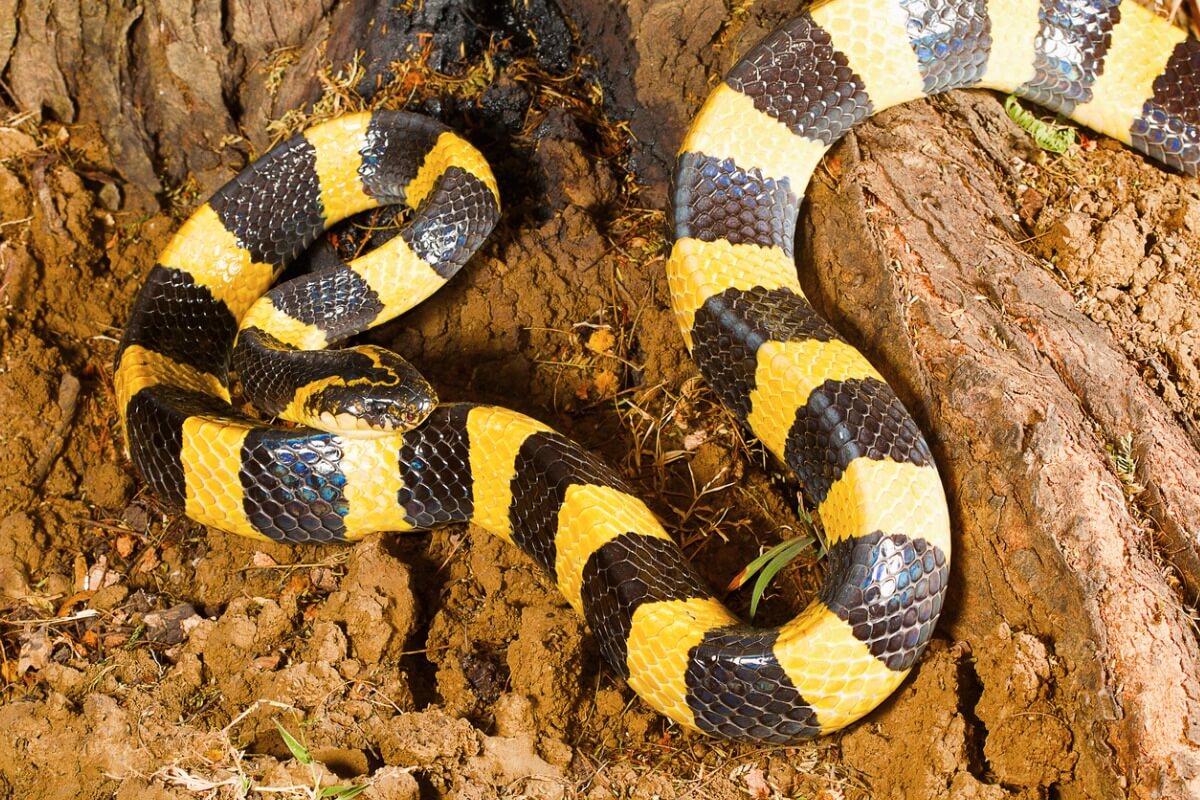Scientists Identify a New Species of Poisonous Snake in China

There are about 1,400,000 identified living species in the world, of which about 70,000 belong to the group of vertebrates. However, even though these figures seem incredible to us, every day more discoveries are added, so the numbers are increasing. This is the case of a new poisonous snake identified by experts in China this year. Read on to find out more about it!
The snake that concerns us here belongs to the group of Kraits (genus Bungarus). This group includes the most significant snakes on the Asian continent (medically speaking) and it’s no wonder, as they produce a venom to be reckoned with.
The discovery
A group of researchers published information in the journal ZooKeys (2021) about a new species of poisonous snake located in southwestern China and northern Myanmar. The scientists featured in the story are Chen Ze-Ning, Shi Shen-Chao, Vogel Gernot, Li Ding, and Shi Jing-Song.
The interesting thing about the story is that these experts became aware of the existence of this ophidian because of the characteristics of its bite, as in the Bungarus group some specimens are similar in physical appearance and are difficult to distinguish from each other.
In the case of this new species, the bite produced intense pain in the patient and a darkening around the wound. This fact caught the attention of professionals and led to further analysis, as it didn’t correspond to the bite mark of any snake already discovered.
Collections of several snakes were made in Yunnan province between 2016 and 2019. The evidence found regarding the DNA and morphology of the analyzed organisms allowed experts to establish a better classification and identify a new specimen. Important physical characters emerged in the specimens’ dentition, scales, coloration pattern, and hemipenis (copulatory organ).
The correct identification and delimitation of venomous snakes is important for humans. On the one hand, it helps to prevent bites and establish an accurate diagnosis. In addition, it’s essential in the development of antidotes and treatments according to each bite.
What’s the name of the new venomous snake in China?
The new snake was named Suzhen’s Krait after the Chinese goddess “Bai Su Zhen” (translated as white snake), which takes the form of an ophidian, transforms into a woman, and falls in love with a man in Chinese legends. This character is the protagonist of a very popular story in Chinese mythology.
From a scientific point of view, the new ophidian has received the name of Bungarus suzhenae (Family Elapidae). Sixteen species are counted in the genus, together with the discoveries of the last years: B. slowinski B . persicus in 2005, in northern Vietnam, and B. persicus in 2014, in Iran.

What does Suzhen’s krait look like?
The new species is very striking, but don’t be fooled: it carries a venom that can be lethal. It’s characterized by its black coloration on the dorsal part (both head and body), with between 26 and 38 white bands (some incomplete) and 12 in the tail area.
The ventral region is clear (yellowish-white). The scales on its head are smooth, and the reptile has small, oval-shaped, dark eyes.
In the case of the taxonomy of B. suzhenae, the number of bands is one of the aspects used to differentiate it from other kraits.
The size of the species is variable. One of the young specimens collected measured 62 centimeters in its body length, while the tail measured 10.9 centimeters, for a total of 72.9 centimeters – 2.4 feet). For its part, an adult male reached up to 114 centimeters (3.7 feet).
Another aspect that stands out from its morphology is the presence of 3 posterior upper teeth that have a slight backward curvature. The hemipenes are large, slightly elongated, and with spines similar to fangs. They have a hard consistency, as they’re keratinized.
Other characteristics of the new Chinese snake
The reptile Bungarus suzhenae was collected in areas cultivated with rice or in streams in monsoon forests with a wide range of altitude, between 800 and 1560 meters (2600 – 5100 feet approx.) in the geographical area of Yingjiang County in Yunnan Province (China) and Kachin State in Myanmar.
A curious fact is that this species consumes eels and other small snakes in captivity and doesn’t like frogs and mice.
There are parts of the biodiversity of our planet that we still don’t know too much about, as every day more specimens are added to the list of living beings. Such is the case of China’s new poisonous snake.
As we’ve seen, the poisonous snake we’ve told you about today is a striking ophidian with a black back, on which several white bands stand out. However, as we’ve mentioned, it produces a venom that can be lethal and its bite is very painful, so be careful if you come across it one day!
All cited sources were thoroughly reviewed by our team to ensure their quality, reliability, currency, and validity. The bibliography of this article was considered reliable and of academic or scientific accuracy.
- Kuch, U., Kizirian, D., Nguyen, Q., Lawson, R., Donnelly, M., & Mebs, D. (2005). A new species of krait (Squamata: Elapidae) from the Red River System of Nothern Vietnam. Copeia, 4, 818-833.
- Ze-Ning, C., Shen-Chao, S., Gernot, V., Li, D., & Jing-Song, S.(2021). Multiple lines of evidence reveal a new species of Krait (Squamata, Elapidae, Bungarus) from Southwestern China and Northern Myanmar. Zookeys, 1025, 35-71.
This text is provided for informational purposes only and does not replace consultation with a professional. If in doubt, consult your specialist.